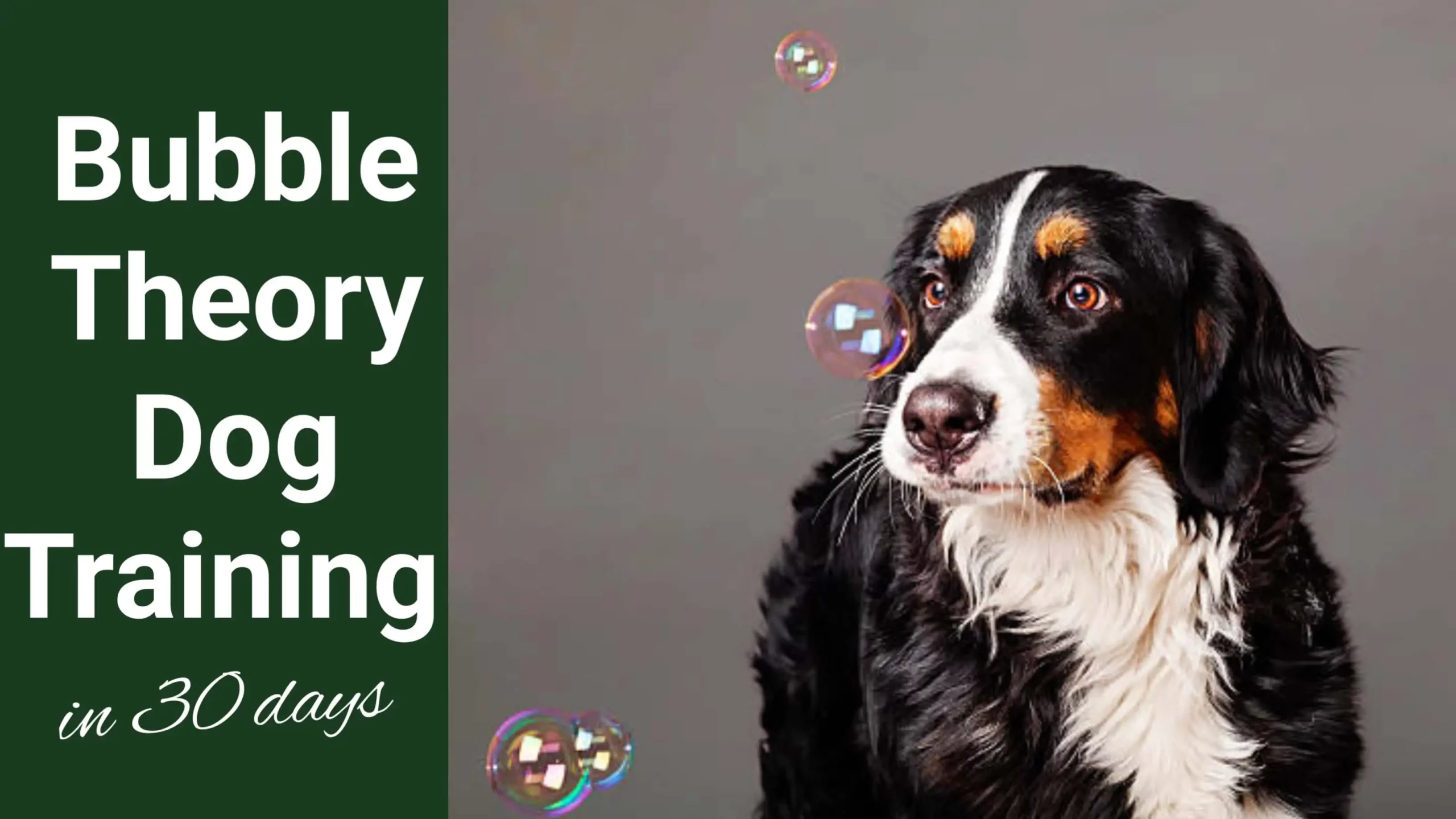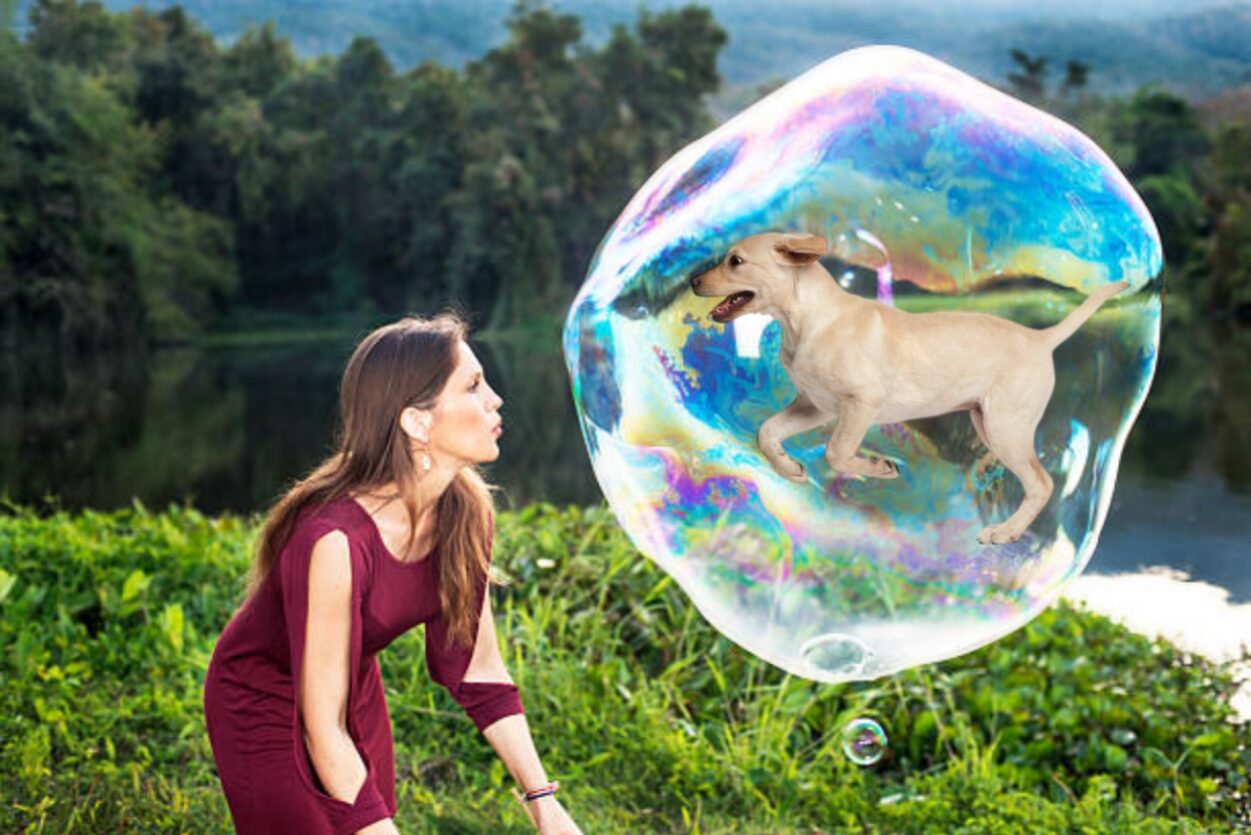
Our dog Jayden is playful, active, and obedient. He loves jumping all over me and plays with confidence. However, he is reactive. Sometimes, it gets hard to board him when traveling as he doesn’t want anyone besides my family around him.
We all might have had a pet like Jayden that shuts down and gets aggressive when someone gets into their personal space. The dog feels like you want to pop their bubble. The good news is you can train a reactive dog using the bubble training theory in 30 days.
Herein, we will guide you on how to socialize your dog, why you shouldn’t hate a reactive dog, and how dog owners and dogs benefit from this exercise.
What Is Bubble Theory?
- The bubble represents the personal space around your dog
- The bubble is a semi-permeable membrane through which dogs interact with their surroundings.
- Your dog will be reactive to the handler if the emotional energy isn’t flowing smoothly, hence the bubble problem
What Is Bubble Theory for Dog Training?
Bubble theory is an innovative training approach focusing on safety and personal spaces. Dog owners use an understanding of emotions to counter reactive behavior and achieve emotional thresholds.
The dog reactivity bubble theory bases its argument on the understanding that, like humans, dogs have boundaries. Hence, they need a positive, welcoming, safe environment to open up, grow and learn.
Reactive behavior is broad; you shouldn’t limit it to snapping, lunging, and barking. Dogs that exhibit these reactions are often anxious and fearful.
Common triggers of dog reactivity include the following:
- Fast-moving objects like skateboards and bikes
- Erratically moving children
- Strangers (adult humans)
- Sound ( like fireworks, thunder, and chants)
- Other dogs
Bubble theory dog training helps change your dog’s response to triggers. The approach emphasizes communication and building trust between owners and dogs. It also helps change the emotional response of a fearful dog to a tolerant and positive one.
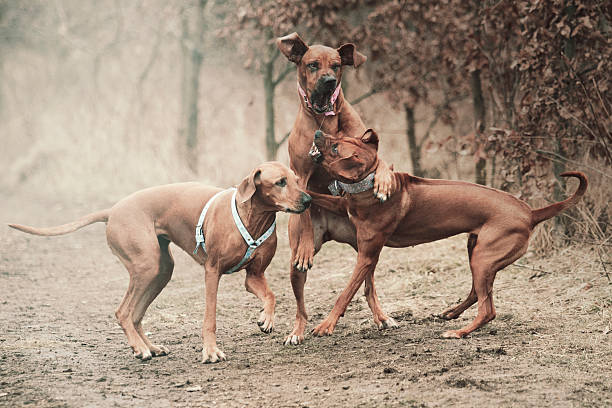
The Bubble Problem, How Bubbles Fit In, & Emotional Threshold
1. The Bubble Problem
Jayden, my dog, used to be reactive to other dogs even when they are on leash. Once he spots another dog 110 yards away, he stops, freezes, and activates his prey instincts.
There is a bubble around the dog, and energy from an aggressive dog cannot flow smoothly to the handler. Hence, the leash holder cannot act as a filter to absorb the dog’s energy and refine it into smooth waves.
Bubble theory physics explains that your dog will instead focus on compression-related sensations. This is the main feature of negative experiences, and your dog will have to summon past experiences from its emotional battery.
Afterwards, when another dog gets into your dog’s personal space, he may overload and bristle. The bubble is a semi-permeable membrane that lets in positive energy and keeps off what it perceives as “toxic.”
When the bubble membrane is open, other dogs will access your dog’s perceived space. If you can train the dog and get access to its bubble, you will be helping other dogs as well.
The more incredible your dog’s prey instincts are, the bigger its bubble problem is. However, once you are in the bubble, letting everybody else in is easy.
2. How Do Bubbles Fit In
If a dog on leash is in their prey instincts, it will be emotionally stimulated and pass the energy to its handler. But if they cannot communicate, there will be no energy flow.
Hence, my dog will pull on the leash and bark fiercely when the other dog gets closer. At this point, the dog is deaf to any command, and you can hardly be in control. If the dog gets loose from the leash, the dog may bite someone or other dogs; the situation is embarrassing.
Applying the Bubble Theory in Dog Training;
A reactive dog on a leash is always scared, anxious, and gets stressed when other dogs are around.
The dog may be under-socialized or have memories of previous attacks while on a leash and couldn’t escape. Several other minor experiences that are in the dog’s emotional battery combine to put a dent in a dog’s social confidence.
The personal space reactive dogs need to feel safe is THE BUBBLE. Dogs that are out of the bubble don’t make the dog feel threatened. However, dogs at the edge put the dog on “high alert” mode.
On the other hand, dogs that step into the bubble make the dog reactive, as they will want to drive them out. Hence, the dog’s bubble is the amount of personal space your dog will want around them to feel safe.
3. Emotional Threshold
A reactive dog’s emotional threshold is the point at which a dog’s emotional response towards an event gets out of hand and is uncontrollable.
We can relate thresholds to bubbles, only that ‘threshold’ falls under your dog’s mental state, and the ‘bubble’ is how the emotional threshold relates to the surrounding environment.
Simply put, a reactive dog will exceed its emotional threshold when triggers get into its bubble.
With bubble theory dog training, you can gradually manipulate the size of your dog’s bubble. If consistent, this brain training for dogs is practical within 30 days. Afterwards, your dog will start tolerating things that used to trigger them.
What Are Some Interesting Facts About Bubbles?
Bubble theory dog training helps us appreciate the relationship between a reactive dog’s emotional state and the surrounding. But why bubbles and not a kennel, fences, or a field?
The reason why we use the bubble analogy as one of the dog training techniques is that bubbles are fragile. Hence, we recommend applying the theory with positive reinforcement. Otherwise, the bubble pops.
Having a reactive dog is stressful and breathtaking. It robs us of the joy of owning and walking around with a dog. Hence, we understand when you get anxious about a solution.
Which Dogs Can Benefit From Bubble Theory Dog Training
If your dog exhibits signs of fear towards things, bubble theory dog training may help. The following are signs that your dog is fearful:
- Rapid blinking
- Flickering eyes
- Nose licking
- Yawning
- Fidgeting
- Trying to run away
- Turning ears backward
- Staring
- Snapping
- Biting
- Growling
- Freezing into a rigid pose
Your dog may not exhibit all these behaviors at any given time. As well you may miss noticing them early enough.
How To Use Bubble Theory Dog Training
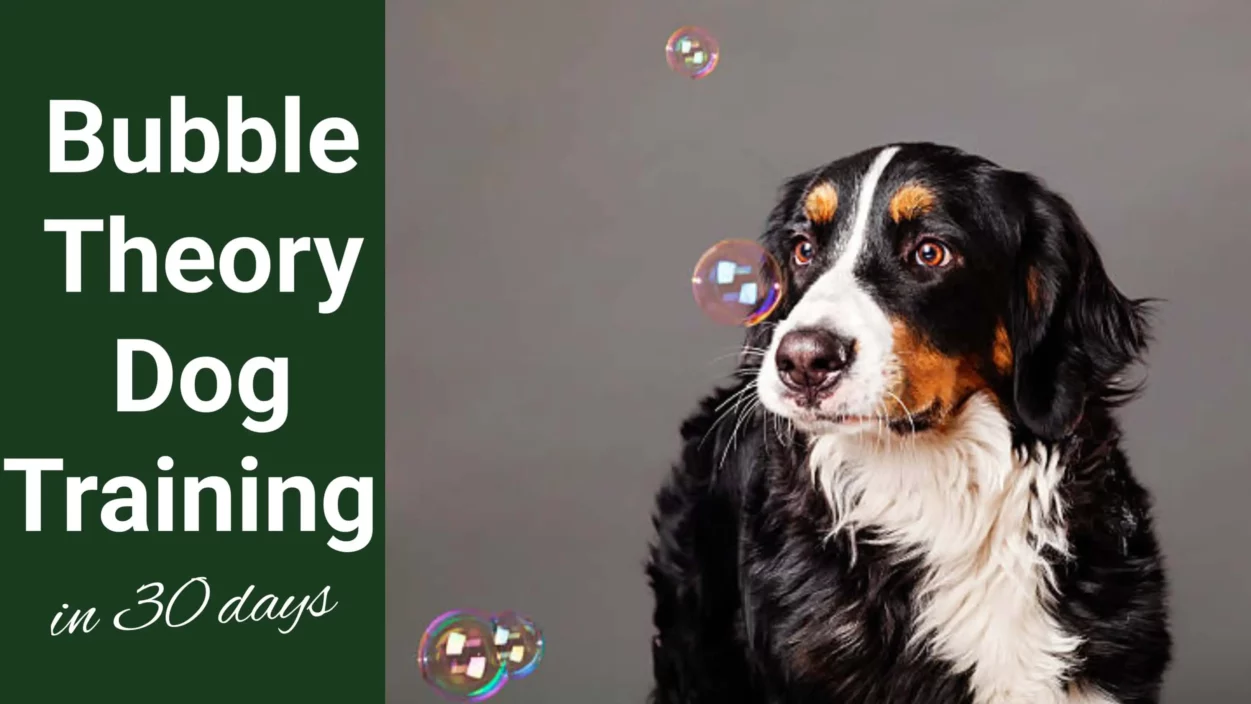
1. Help the Dog Shrink its Bubble
You should help your dog feel comfortable around things that make them reactive by getting closer enough to them and assuring them of safety.
A fearful dog may feel insecure and react negatively. But after one week of constant company, they would have allowed you into their space, and that’s how to socialize a reactive dog.
2. Using Eye Contact, Train within the Dog’s bubble
Once the dog lets you into their personal space (the bubble), you should begin the actual training.
In this step, eye contact is critical. Get close to their face and look your dog in the eyes. Eye contact with dogs lets you connect emotionally and build an immense relationship.
Eye contact may work best while you serve your dog their best treat. After each successful “eye contact,” reward the dog with a treat.
With eye contact, your dog will easily understand commands.
3. Help your Dog Remain Calm While in Their Bubble
You are already in the dog’s space bubble. However, the bubble is small, and you should help your puppy feel comfortable with any dog approaching.
While looking your puppy in the eye, move away and increase the distance in between. When you move too far, the bubble exceeds its limits and pops.
Try walking your dog around, as they will get used to the environment. The best time to walk a reactive dog is early in the morning or very late in the evening, when the surrounding is less active, no vehicles pass by, and fewer people are on the way. However, keep your distance from strangers.
Distance helps in brain training for dogs in an open environment. Your dog will learn to appreciate tiny and huge bubbles at this stage.
Also, introduce other dogs and people to your pup. However, ensure your puppy is comfortable and doesn’t exhibit signs of fear. Guard your dog, and don’t let other dogs invade your dog’s personal space.
4. Counter Condition Fearful Behaviors
Counter Conditioning in bubble theory dog training helps change your dog’s negative response to a better one. When letting other dogs and people into your dog’s space, you should note how its bubble of pressure reacts and if it will be welcoming.
At this stage, you can also use high-value treats. When your dog sees the trigger next time, they will anticipate a high-value meal, and that’s how you condition them. If food doesn’t make your dog happy, use their best toy.
Fun Tip: you can only change your pup’s emotional response from only the calm side of the emotional threshold. Once they go overboard and exceed the threshold, you will have to take the trigger away; that’s how imagining a dog’s personal space bubble comes in.
When counter Conditioning, ensure the dog’s triggers are outside the bubble. As your dog’s emotional response changes, the bubble will reduce in size. In return, the triggers can get close without the dog showing signs of fear.
But if the trigger bursts through the dog’s bubble, you will have to suspend that training session. It may also make your dog more reactive in subsequent sessions. You shouldn’t hate your reactive dog, as it’s your job to protect the bubble!
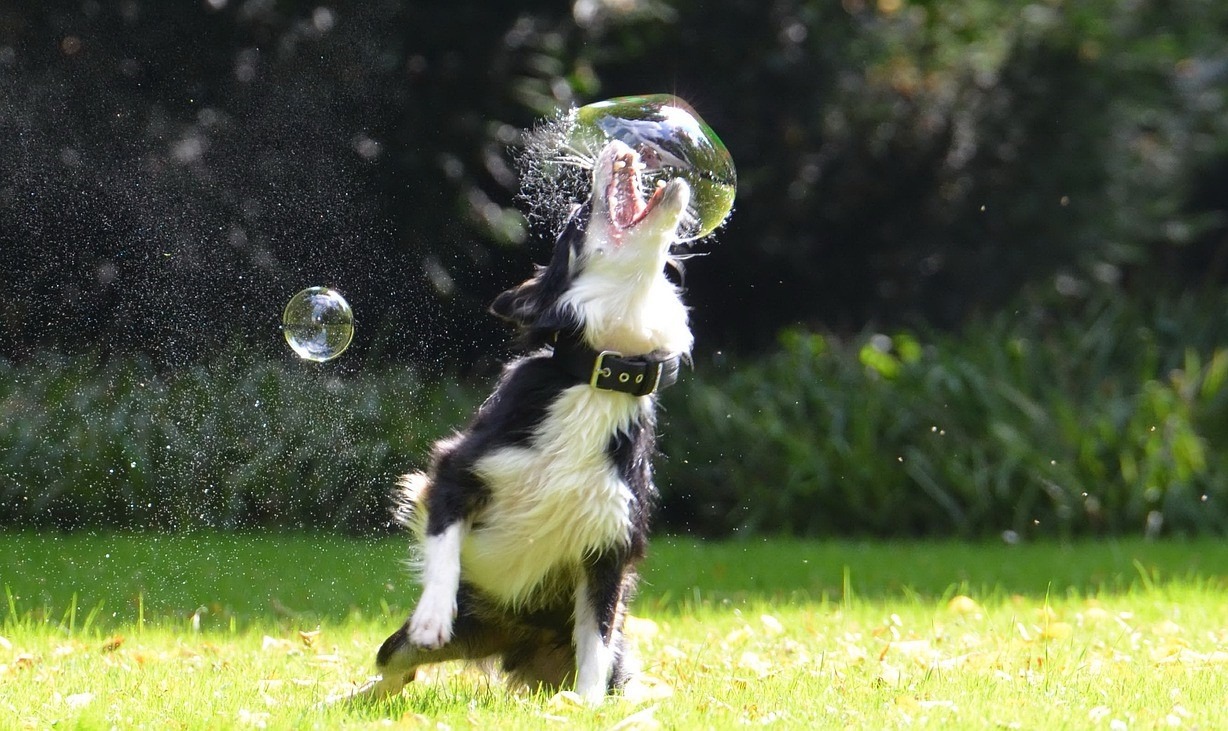
You can consistently train your dog using the above steps in 30 days. The following month you should have your playful and accommodating furry friend.
Benefits of Bubble Theory Dog Training
The benefits of using bubble theory dog training include the following:
- Improved obedience and behavior: helps in dealing with unwanted behavior
- Lasting Result: once your dog gets rid of its fears, it becomes less reactive for the rest of their life
- Bond building: bubble Theory dog training will help you build a strong bond with your dog
- Increased Trust: Bubble theory fosters trust with your dog through communication.
- Positive outcomes: the bubble theory dog training technique has always resulted in positive outcomes through training.
- Helps you understand your dog: this dog training approach enables you to understand your dog’s fears and weaknesses and enables you to deal with them.
- Helps address specific behavioral issues: some habits like fidgeting and nose licking may often be to a point they look normal. This technique will help you identify them and counter their effects on your dog.
- Creating a safe space: In protecting your dog’s bubble, you will have created a secure environment for them to grow and heal from their reactivity.
Also, introducing your dog to different people, dogs, and experiences at other times helps lower aggression risks and reactive behaviours.
Wrap Up on Bubble Theory Dog Training
The bubble concept helps us recognise and appreciate the limits and weaknesses of our dogs. You can help them adjust the bubble size and stop being fearful.
Bubble theory dog training revolves around counter conditioning, and it’s easy to follow as you already know the triggers. After recognising and appreciating your dog’s personal space, you won’t push past the dog’s emotional threshold and physical boundaries.
Pet Grail recommends you talk to a vet or a professional dog trainer if your dog exhibits complex behaviors like pain. We would love your opinion about using the bubble theory dog training technique. How fast did your dog respond? Leave a comment below!

